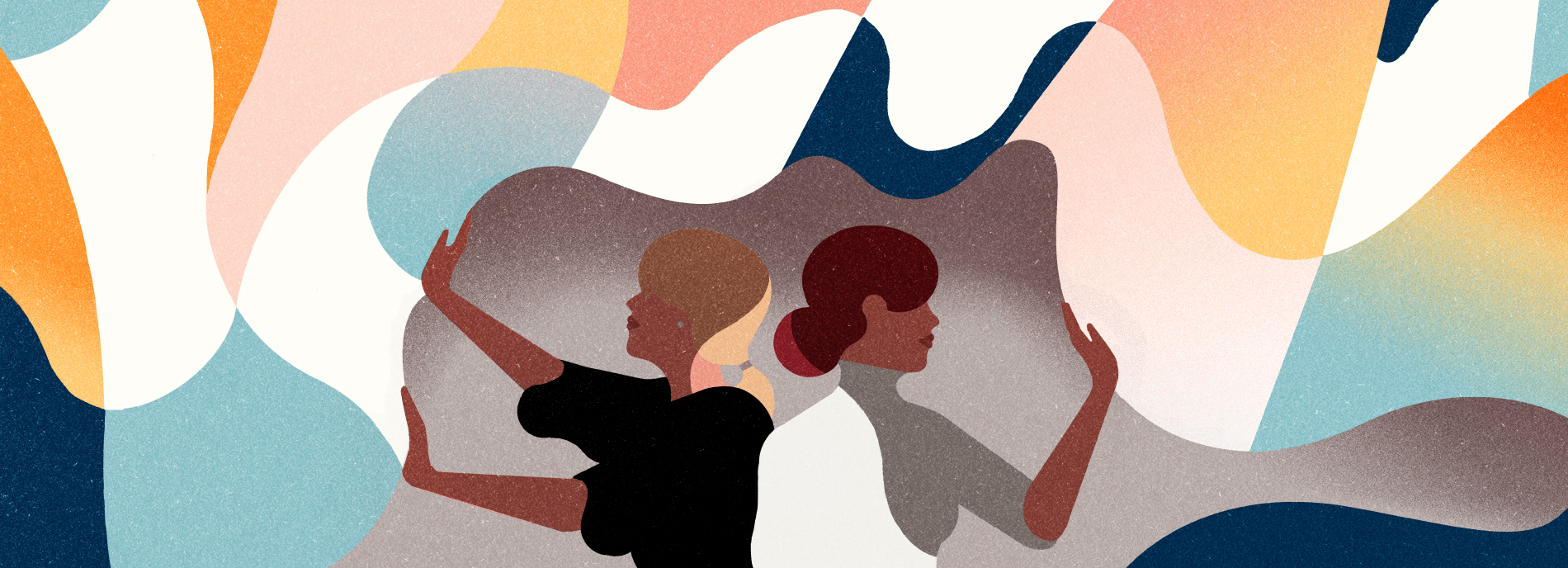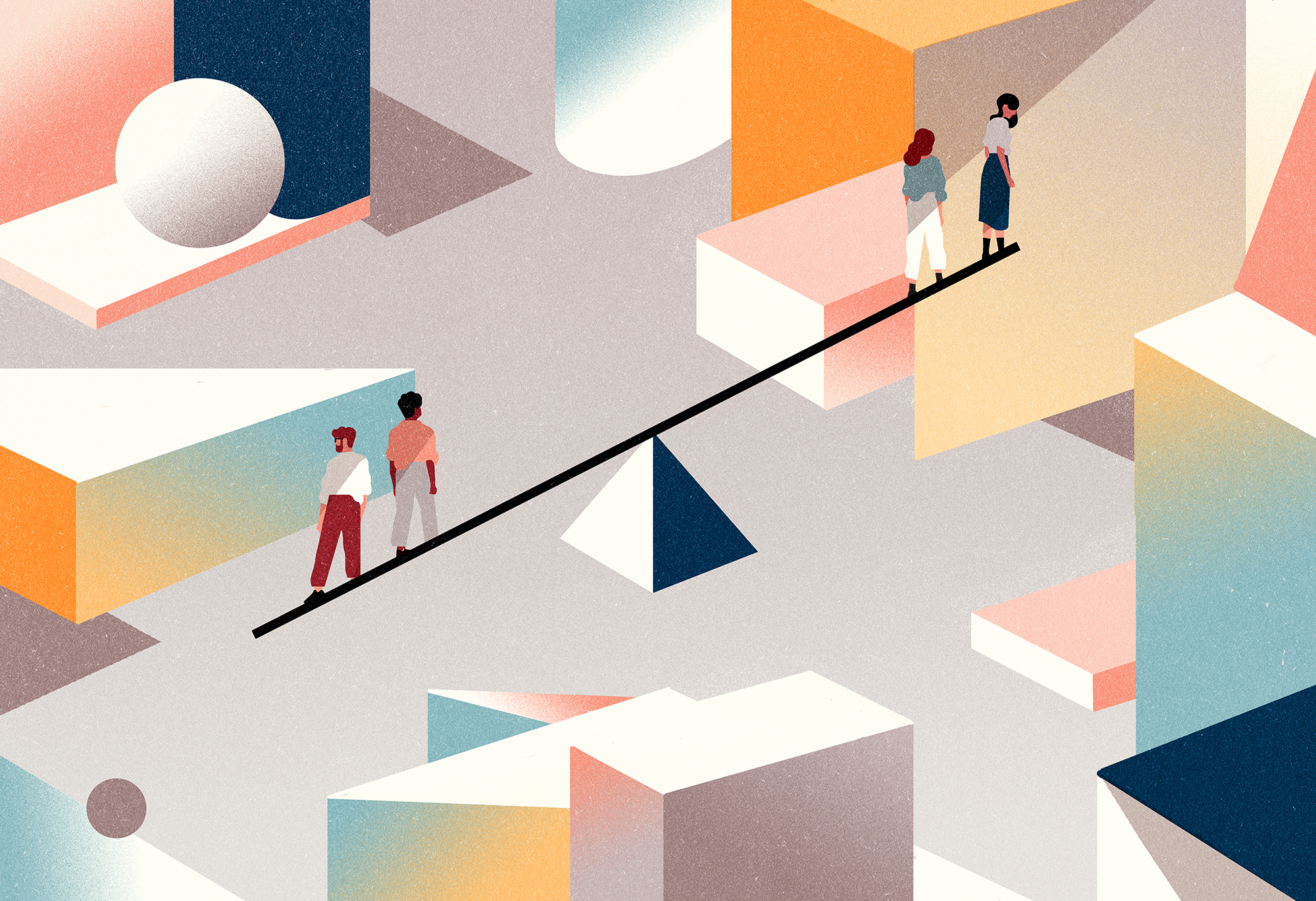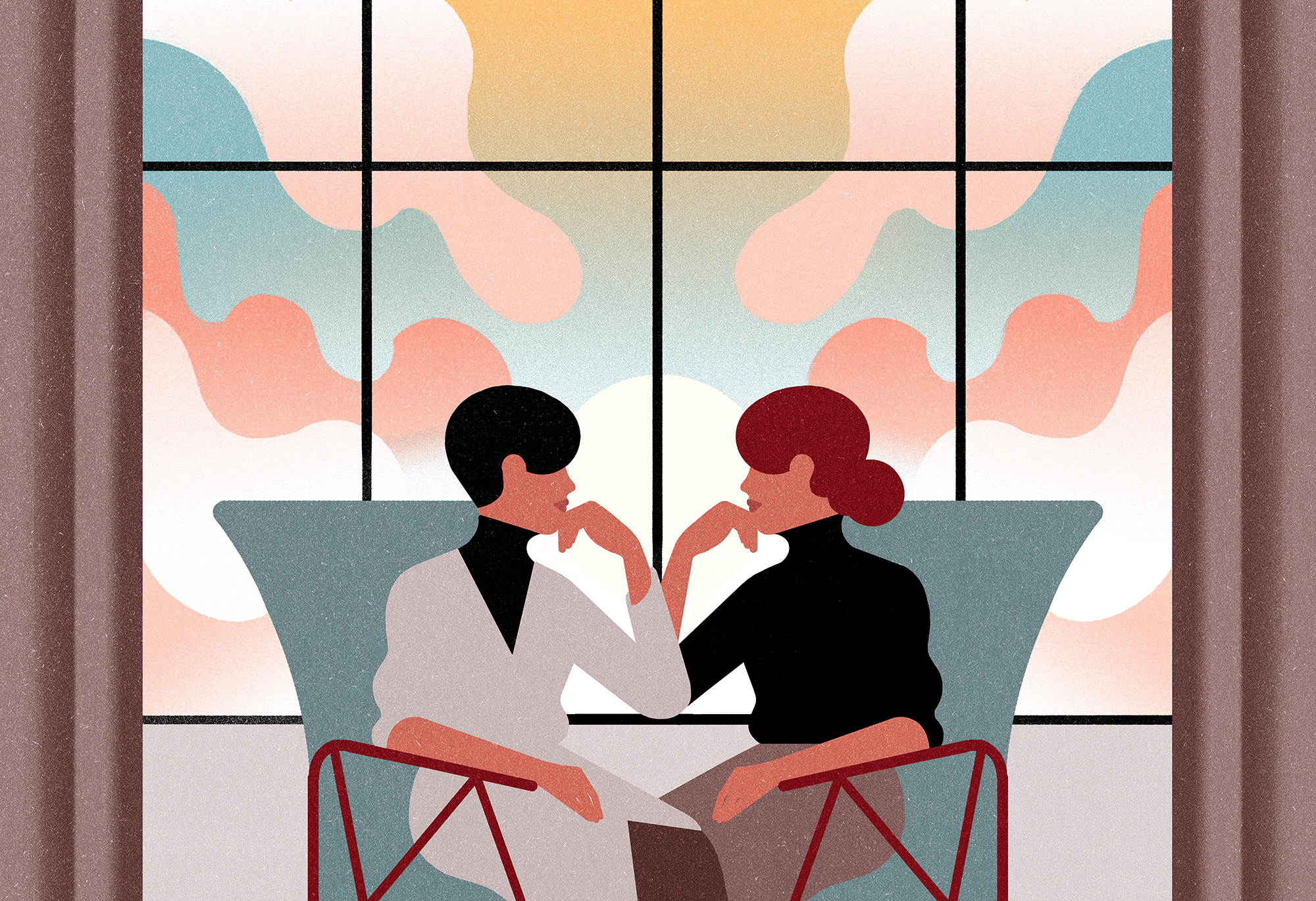
Righting the gender imbalance in autism studies
Autism doesn’t just affect boys and men, but research on the condition still predominantly focuses on them. Some scientists are finally beginning to include women and nonbinary people in their studies.
F
or the first 42 years of her life, Sharon daVanport assumed that everyone finds the lights at the grocery store overwhelming. As a child, she knew it was unusual that she rocked back and forth and banged her head on her bedroom wall after school, but she didn’t worry about it. Even after her youngest son, J.D., was diagnosed with autism at age 5, she did not draw any parallels between his behavior, which also included rocking, and her own — although her mother did notice some similarities between them.Then, 12 years ago, when her autistic son was 12, daVanport learned she too has autism. And then she understood all sorts of things — including why she had trouble relating to the other parents in the online communities she sought out after J.D.’s diagnosis. She began searching for a new kind of support network, one for autistic adults.
Her quest quickly snowballed into a new life. After befriending several women online, daVanport helped create a website and discussion forum that evolved into a nonprofit, the Autistic Women and Nonbinary Network. She became its executive director.
Bolstered by that community, daVanport realized why it had taken her so long to find her tribe: She and other women with autism were being ignored — not just by society but by science. When the group reviewed studies about autism, she says, it was typical to see mostly male participants. “Here we are, like hundreds and hundreds of women talking online who are autistic, and we’re finding each other, but researchers don’t know about us,” she says.
Evidence that clinicians are missing girls with autism has been building for years. Because autistic girls tend to exhibit different traits than autistic boys do, they are frequently overlooked by teachers, doctors and standard diagnostic tools. Those omissions carry over into the research literature, where studies typically include three to six males for every female, says William Mandy, a clinical psychologist at University College London.
As a result, researchers don’t yet know enough about gender differences in autism — and so they miss girls whose traits differ from those of boys. It’s a vicious cycle, Mandy says: “You are inheriting any diagnostic bias that is built into the system.”
To break the cycle, some researchers, including Mandy, are making it a priority to recruit female and nonbinary participants into their studies. And some are turning to women like daVanport and gender-nonconforming autistic people for guidance on how to design better studies and cast a wider net when recruiting participants. DaVanport has been an adviser on one study for more than a year. She and an autistic colleague solicit feedback from a group of about 20 autistic people, and she attends weekly meetings to share their thoughts with researchers on what it is like to be autistic beyond the typical definition.
Improving the sex and gender balance in autism studies could transform our understanding of the condition, just as it did for heart disease in women. Without that balance, says Lauren Kenworthy, who leads the team, “we certainly miss opportunities to provide effective treatment or to understand what effective treatment might be.”
”“Studies with children may not capture the full picture of female autism.” Francesca Happé
The girl gap:
A
utism is often cited as being four times as common in boys as in girls. But some researchers question this statistic, saying the true ratio is likely to be less skewed because so many autistic girls go unidentified. In one study of autism diagnoses, for example, Mandy’s group found a ratio of three males to every female.Still, most studies cite the 4-to-1 ratio as fact, and their participant ratios are often even higher. One 2012 meta-analysis of brain-imaging studies has a ratio of 15 males for every female. Because they include so few girls and women, many studies don’t stratify their results by sex or gender, and they report their male-based conclusions as universally applicable, says Rene Jamison, clinical associate professor at the University of Kansas in Kansas City.
In a typical trial of 50 participants that might include 10 girls, statistical analyses cannot distinguish whether the results in girls differ from those in boys. But by reporting those results as applicable to anyone with autism, scientists do a disservice both to girls, who might have different needs than boys do, and to boys, whose results might be diluted by the inclusion of girls. “To specifically look at whether a treatment differs as it applies to boys versus girls, it’s best to have an equal sample size of the two sexes,” says Meng-Chuan Lai, who studies gender and autism at the University of Toronto. “That’s something that really hasn’t been done.”
One challenge with recruiting women and girls into autism studies is that they tend to accumulate misdiagnoses or additional diagnoses, including bipolar disorder, depression and anxiety — often delaying their autism diagnosis. Some studies specifically exclude participants with additional diagnoses and, in doing so, may also exclude girls on the spectrum. “As a result, studies with children may not capture the full picture of female autism,” says Francesca Happé, professor of cognitive neuroscience at King’s College London.
Another reason some studies stick with boys is that because there are fewer girls and women with autism diagnoses, recruiting them for research can be expensive, says Clare Harrop, a developmental psychologist at the University of North Carolina at Chapel Hill. Harrop relies on an autism registry maintained by the university and has found that girls on the list often live as far as five hours away, meaning they sometimes need to be offered an overnight stay. By contrast, the boys on the list typically live within two hours from campus.
Harrop and her colleagues have shown why scientists should make the effort anyway.
Tapping this registry, they set out to replicate the results of an earlier study that had included only one girl — this time enrolling equal numbers of boys and girls. The original study used eye tracking to show that preschoolers with autism are more interested in looking at objects than at faces. Harrop’s team followed the same protocol with children aged 6 to 10 but found that autistic girls look at faces more quickly and for longer than autistic boys do. “Their attention fell on the continuum somewhere between girls without autism and boys without autism, but the social attention was different from boys with autism,” Harrop says. “We just replicated one study and we found totally different results by including girls.”
Mandy’s team has found another way to recruit girls and women with autistic traits: online. Some of the most active bloggers, tweeters and commenters discussing autism online are women, he says, highlighting another intriguing way that autistic women may differ from autistic men: They are driven to connect. “You almost get a backlog of women who weren’t diagnosed in childhood,” he says. These women are part of a growing online chorus that also includes people of color with autism and those who identify as LGBTQ+.

Hiding at the edges:
A
mong prominent autistic bloggers is Rua M. Williams, a nonbinary graduate student at the University of Florida who blogs about autism and gender identity. Williams was not diagnosed until age 31, in part because they did not fit the criteria that doctors are trained to look for, Williams says. “Until we attend to the full diversity of autistic traits in confluence with gender, sexuality, culture, ethnicity, race, class,” Williams says, “we will continue to miss people, and they will continue to feel lost.”Cultural expectations also perpetuate the idea that autism primarily affects boys. In one ongoing study, Mandy and his team present elementary-school teachers with scenarios describing a child whose name is sometimes male, sometimes female. So far, they have found that the teachers are more likely to suspect that the student is autistic if the student has a male name, Mandy says.
Societal expectations also compel many girls to camouflage their traits — which can further keep them from being identified and recruited into research. As a child of immigrant parents from West Africa growing up in the United States in the 1990s, Morénike Giwa Onaiwu worked hard to fit in. She started talking early and excelled in school, but she also showed many signs of autism: She rarely made eye contact, and she picked at her skin and made humming noises to soothe herself. She developed obsessive interests and was sensitive to smells and textures — so much so that she had holes in her clothes from ripping all the tags out. And she was extremely literal, which often got her into trouble at school.
Realizing she was different but not understanding why, she grew depressed and anxious, and had suicidal thoughts. “Everything was so easy for everyone and so hard for me,” says Onaiwu, who is now co-executive director of the Autistic Women and Nonbinary Network and chair of the organization’s Autism & Race Committee. To try to fit in, she studied what her friends were doing — how they dressed, spoke and told jokes. And she founds ways to self-soothe that were socially acceptable, like playing with her hair. Onaiwu was not diagnosed until she was 31, after both of her children received diagnoses and their neurologist suggested that she get evaluated, too.
Beyond this world of women who compensate for their traits so well that they go undetected for much of their lives is another group of ‘girls on the edge’ — those who don’t quite meet the diagnostic criteria for autism but come close. These girls may well hold the keys to helping scientists fully understand sex and gender differences in autism, says Kevin Pelphrey, Harrison-Wood Professor of Neurology at the University of Virginia in Charlottesville.
Pelphrey directs a network of colleagues around the U.S. who are investigating sex and gender differences in autism. All six sites of the project, funded by a National Institutes of Health grant, maintain records of such girls. The girls tend to be socially awkward but extremely interested in social interactions; they make eye contact but have restricted interests, albeit different from those seen in boys — “like an encyclopedic knowledge of Disney characters and their insights and their relationships, and you’re kind of like, ‘That’s terribly social; what do I do with that?’” Pelphrey says. “What we’ve decided to do with them is study them.”
Studying both girls (and boys) on the edge, Pelphrey says, is the only way to get a full understanding of how sex and gender differences should shape diagnosis and treatment of autism. “If we’re only looking at the overlap between boys and girls, we could come to some dramatically incorrect conclusion because of the way we’ve defined autism,” he says. “Maybe only studying those that meet certain diagnostic criteria will predetermine us to failure because of the language that we use to constrain the problem.”
Jamison, too, is launching a study to follow ‘girls on the edge’ to understand how autism traits look different in girls over time. She is particularly interested in the girls’ transition from childhood to adolescence — when those who have mastered basic play skills might start to face new social challenges. She recruits some of these girls from a registry more than a decade in the making. In 2008, she devised a social-skills program called Girls Night Out. Since then, she has compiled a list of about 180 girls and young women who have either completed the program or are waiting for an opportunity to participate, but who do not all have autism diagnoses.
”“We just replicated one study and we found totally different results by including girls.” Clare Harrop
Adapting practices:
A
s scientists learn more about how autism traits manifest in all these different groups, they are including input from autistic people in their study designs and treatment approaches.Kenworthy, for one, is seeking help from daVanport and other autistic people to devise questions that capture the internal lives not just of girls and nonbinary people on the spectrum, but also boys who don’t fit the traditional criteria. She is also coming up with questions that can help to identify these people. She plans to ask women, as well as gender-diverse individuals and other neglected groups, to review the questions.
These new questions reflect stories she hears from daVanport and others, who say they learned gestures or eye contact through practice. Traditional diagnostic screenings give credit for the behavior without recognizing the intense effort and learning that can be behind it. “We think a huge piece that has been missing from our work is understanding the inner experience of autism, and maybe that has an especially strong penalty for females,” Kenworthy says.
It did for daVanport, who faced misunderstandings from an early age. As a teenager, she struggled to eat. Peas tickled her teeth. Mushy foods made her gag. She hid food in her napkin to avoid trying to explain why she was not eating it. Even so, when she got an anorexia diagnosis, it didn’t make sense to her. “I was doing all those things that anorexic people do because they don’t want to gain weight. But I did it because I could not swallow the food without throwing up,” she says. “I knew I was too thin and I wanted to be heavier, but they thought I was just lying; I literally had a doctor look at me and say I was lying.”
Up to 20 percent of girls and women in eating-disorder clinics have undiagnosed autism, and they may have different treatment needs. “You could imagine that once you knew they were autistic, you could make a few changes,” Mandy says. For example, if they have intense aversions to food smells, a treatment protocol that requires them to eat in a group setting could make them even less likely to eat. He is recruiting participants to better understand the intersection between autism and anorexia nervosa.
Likewise, separate brain regions appear to respond to cognitive behavioral therapy in autistic girls versus autistic boys, says Pelphrey — differences that could also inform treatment choices. Typical social-skills groups, too, might not work for teenage girls with autism, who form friendships that are more similar to those of typical girls than of autistic boys. “You can get a group of six, with five boys and one girl,” Lai says. “It’s pretty likely that a girl will say, ‘Well, I don’t want to join this because it doesn’t fit my friendship experiences.’”
Clinicians could make a difference simply by really hearing people like daVanport. Mandy remembers one woman with anorexia who complained that a brightly lit treatment room was overwhelming for her. “She asked that the lights be turned down, and the clinician said she was being manipulative and refused to turn the lights down,” he says. “This is one example of a low-hanging fruit.”
For daVanport, being listened to by scientists is empowering after years of being ignored. “I went into this totally expecting that I’d be part of meetings where I’d have to be sending emails after the meeting saying, ‘Hey, you spoke over me completely and shot everything I said down,’” she says. But that hasn’t happened. “I hope that this research collaboration will champion a shift in centering autistic people and looking at the whole spectrum of gender.”

Recommended reading

Expediting clinical trials for profound autism: Q&A with Matthew State

Too much or too little brain synchrony may underlie autism subtypes
Explore more from The Transmitter

This paper changed my life: Shane Liddelow on two papers that upended astrocyte research
Dean Buonomano explores the concept of time in neuroscience and physics

